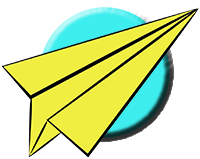Easy Hammerhead Paper Airplane Folding Instructions
Easy Hammerhead Paper Airplane Folding Instructions
Instructions
1. Start with medium letter size paper (8.5 inches x 11 inches).
2. Fold the paper in half exactly along the edge.
3. Turn the paper so the crease is to the right; the paper should open up on the left hand side.
4. Make a crease to fold the tail. The crease should be about three finger widths from the right along the bottom along the right edge. Unfold after the crease has been made
5. Unfold the paper and lay it flat on the surface. The creases made for the tail should be at the bottom.
6. Fold the upper right corner down to the upper right point hits the center line crease. When folded correctly, the right half of the top edge should line up with the center line crease.
7. Fold the upper left corner down so the upper left point hits the center line crease. When folded correctly, the left half of the top edge should line up with the center line crease.
8. Make a crease to fold the point at the tip of the nose down so it hits the center crease. The crease should be about half way between the folded down flaps and the top of the tail section crease.
9. Rotate the paper so the flap folded down for the nose is at the top. Fold the upper right corner down so the upper right point hits the center line crease. When folded correctly, the right half of the top edge should line up with the center line crease.
10. Fold the upper left corner down so the upper left point hits the center line crease. When folded correctly, the left half of the top edge should line up with the center line crease.
11. Fold the small triangular flap, which lies under the larger triangular flaps, over so the point at the tip hits the center line crease. This will lock the larger flaps in place.
12. Flip the paper over so the folded flaps are underneath and the nose is pointing up. Fold the plane in half, to where both sides touch.
13.Pop the tail section up into the fold so it lies between the wing flaps. When folded correctly, the tail section will not be visible, it will be hidden by the wing flaps. Be sure to line up the wing flaps for good balance.
14. Rotate the plane so the nose is pointing to the left and the wing flaps are pointing up.
15. Make a crease for the first wing flap. The left point of the crease should be about two finger widths up from the bottom edge of the fuselage and the right point should hit at the base of the tail crease on the right.
16. Flip the plane so the first wing flap in underneath and the nose points to the left.
17. Make a crease for the second wing flap. Be sure to line up the wing flaps for good balance.
18. Open up the wing flaps and adjust the wing angles so they are even. Set the dihedral angle down to about 45 degrees for better flying stability. Make sure the tail is straight and even.
THE THROW: A good straight flyer when adjusted right, this plane should be launched level or at a slight up angle. Fly with a medium to hard "push" throw. It if spins, try adjusting the back of the tail. A paper clip on the nose adds speed with a large dihedral angle.
